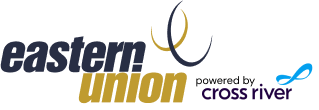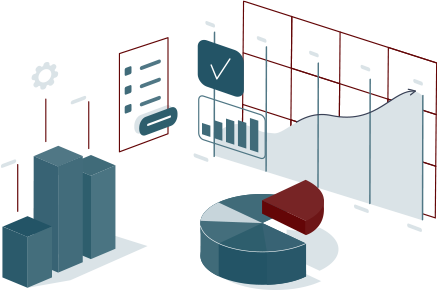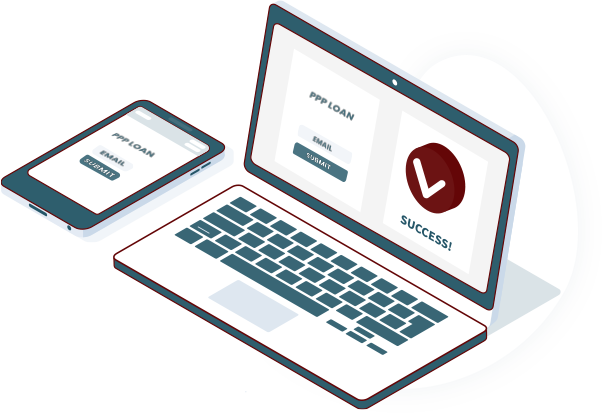GET STARTED HERE

PPP Round B Application is Live!
Enter your email address and click "Continue" to proceed to the application.
Required Documentation
For second-draw PPP loans more than $150,000, you must provide proof of 25% loss.
When you must substantiate that you had a 25% loss in gross receipts/gross income (Gross Profit – COGS) between 2020 and 2019, you can do so by choosing one of the following comparison choices:
- Full year 2020 to full year 2019
- Any quarter in 2020 to the same quarter in 2019
- If your business began in the period of 1/1/2020-2/15/2020 you can compare any Q1 2020 to any other quarter in 2020
- If your business began operation in Q4 2019 you can compare any Q4 2019 to any quarter in 2020
You can compare either quarterly numbers or annual, using one of the following statements/documents:
- Bank Statements (all credits)
- Tax Documents (actuals or drafts)
- Quarterly financial statements
- Driver's License / Photo ID
- Voided Check
- Form 1040 Schedule C
If line 31 is $0 or negative, you are ineligible for a PPP loan. - Bank Statements
Please provide a bank statement that covers 2/15/2020 as proof that the Applicant was in business as of 2/15/2020. If available, bank statements that are downloaded from your bank's website will work better than scanned versions.
- Driver's License / Photo ID
- Voided Check
- Form 1040 Schedule C
If line 31 is $0 or negative, you are ineligible to include this owner's income in the PPP loan calculation. - Bank Statements
Please provide a bank statement that covers 2/15/2020 as proof that the Applicant was in business as of 2/15/2020. If available, bank statements that are downloaded from your bank's website will work better than scanned versions. - Proof of Payroll Form 940
Applicable only if you have employees. While it is preferable to provide a 940, you may provide four 941 quarterly forms instead. If you choose to provide 941's instead of a 940, please make sure that they are four consecutive quarters covering your full calculation period (2019 or 2020). Using 941's may require a manual underwriting which can delay your application.
- Driver's License / Photo ID
- Voided Check
- Bank Statements
Please provide a bank statement that covers 2/15/2020 as proof that the Applicant was in business as of 2/15/2020. If available, bank statements that are downloaded from your bank's website will work better than scanned versions. - Form 1120 or 1120-S
To substantiate health insurance (line 24 of 1120 or line 18 of 1120-S) or retirement benefits (line 23 of 1120 or line 17 of 1120-S) to employees. - Proof of Payroll Form 940
Applicable only if you have employees.While it is preferable to provide a 940, you may provide four 941 quarterly forms instead. If you choose to provide 941's instead of a 940, please make sure that they are four consecutive quarters covering your full calculation period (2019 or 2020). Using 941's may require a manual underwriting which can delay your application. - Form 1040 Schedule C
If line 31 is $0 or negative, you are ineligible to include this owner's income in the PPP application.
- Driver's License / Photo ID
- Voided Check
- Bank Statements
Please provide a bank statement that covers 2/15/2020 as proof that the Applicant was in business as of 2/15/2020. If available, bank statements that are downloaded from your bank's website will work better than scanned versions. - Form 1065
- Form 1065 Schedule K-1
Please provide a K1 for each Partner with self-employment earnings in box 14a. - Proof of Payroll Form 940
While it is preferable to provide a 940, you may provide four 941 quarterly forms instead. If you choose to provide 941's instead of a 940, please make sure that they are four consecutive quarters covering your full calculation period (2019 or 2020). Using 941's may require a manual underwriting which can delay your application.
- Driver's License / Photo ID
- Voided Check
- Bank Statements
Please provide a bank statement that covers 2/15/2020 as proof that the Applicant was in business as of 2/15/2020. If available, bank statements that are downloaded from your bank's website will work better than scanned versions. - Part IX Form 990
A Form 990 does not always need to be filed - this is only applicable if your non-profit files a 990. - Proof of Payroll Form 940
Applicable only if you have employees. While it is preferable to provide a 940, you may provide four 941 quarterly forms instead. If you choose to provide 941's instead of a 940, please make sure that they are four consecutive quarters covering your full calculation period (2019 or 2020). Using 941's may require a manual underwriting which can delay your application. Please note regarding parsonage: Only parsonage expenses that are cash payments qualify and not in-kind parsonage expenses. Alternative methods for verifying parsonage amounts - e.g., receipts, invoices, cancelled checks, or similar documentation (or failing all of those, a certification of the amount paid by the authorized representative of the church or other religious organization) - are allowed.

PPP Program Highlights
Amount
Generally up to $2 million for eligible expenses (exceptions and eligibility criteria vary and may apply).
Forgiveness
Up to 100% if proceeds used for designated expenses while maintaining salaries and headcount for the covered period.
Availability
Our application is open now.
Collateral
No collateral or personal guarantees are required.
Eligibility
Most businesses and nonprofits as prescribed by the SBA (employee count and business entity exceptions may apply). Borrowers applying for a second draw loan may have no more than 300 employees and must show at least a 25% reduction in revenue in accordance with the requirements.
Terms
If proceeds are not used for the designated purposes, the terms are 1% annual percentage rate with maturity of 5 years.
All terms subject to change based on the latest updates from the US Small Business Administration.

Helpful Tips
04
If you require support related to your application, please email the Cross River Support Team at [email protected]. Include your business name and EIN with your email inquiry so that they can help you faster. Please do not include any personal identifiable information in your message.
08
Eastern Union & Cross River Bank is not responsible for any misuse or improper use of the application system.
WHY DO THOUSANDS OF BUSINESSES TRUST EASTERN UNION FOR PPP?

Stay in the loop
You'll receive timely communication on program updates to help ensure that your application can be accurately completed and submitted to the SBA for approval.

Streamlined online application
Experience a streamlined online application process that's easy to follow, backed by technology that has significant loan processing capacity.
Frequently asked questions
Please be advised that the program requirements are subject to change in accordance with SBA guidelines. The below highlights of the PPP Round B program and FAQs are meant to be a non-exhaustive overview and provide applicants only with basic information.
It may take up to 10 days for the closing documents to be sent via DocuSign and for funding to be disbursed once you have been notified of SBA approval. The DocuSign email will be sent to the primary email address used during the application process. Please ensure that the email is not in the spam or junk folder. The loan will not be funded until the loan documents are executed.
No. A borrower must submit their fully executed loan documentation in order to be funded and must return documents within 20 days or the loan will be cancelled.
Once you have executed the loan documents, it can take up to 10 days to receive your funding. You can check your funding status here: https://sbaapply.crossriversba.com/#/findapp
Yes, the program will be open for both first-time borrowers and borrowers looking for a second loan. Please note that the requirements for first-time borrowers and second time borrowers are different. Continue reading below for a non-exhaustive list of eligibility requirements and other helpful information. Please be advised that qualifying as an eligible business does not guarantee a PPP loan will be offered.
Yes, applicants may still apply for a Round B PPP loan through us regardless of receiving a PPP loan from a different lender in the previous round.
Please be advised that only eligible business may apply for a second draw loan. Each business is only entitled to one PPP second draw loan, and previous approval does not guarantee approval for a second draw loan.
Second Draw PPP Loans are generally subject to the same terms, conditions and requirements as First Draw PPP Loans. These terms include:
-
The guarantee percentage is 100 percent.
-
No collateral will be required.
-
No personal guarantees will be required.
-
The interest rate will be 100 basis points or one percent, calculated on a non-compounding, non-adjustable basis.
-
Maturity is five years.
-
All loans will be processed by all lenders under delegated authority and lenders will be permitted to rely on certifications of the borrower in order to determine eligibility of the borrower and the use of loan proceeds.
All applications require a driver's license, voided check, proof of payroll and proof of revenue reduction. Acceptable documentation for proof of payroll varies by type of business. Acceptable documentation for proof of revenue reduction can include one of several options. For a full list of required documents specific to your type of business, please follow the links below:
In addition to the businesses that were eligible in the initial round of PPP (including but not limited to small businesses, nonprofit organizations, veterans organizations, Tribal business concerns, small agricultural cooperatives that meet the SBA size standards, sole proprietors, self-employed individuals or independent contractors), during this round the program includes entities that are 501(c)(6)s, destination marketing organizations (DMOs), housing cooperatives, newspapers, broadcasters, and radio stations. Additionally, for first-time borrowers to qualify for eligibility, the entity may employ no more than 500 employees.
In order to be eligible for a loan, first-time businesses must have been in operation on February 15, 2020.
The absolute maximum cap on loans (both first-time applicants and second draw borrowers) for PPP is $2,000,000. In your application you will be requested to submit certain documentation as proof of eligibility that will determine the amount your business is eligible for under the program. Please be advised that borrowers are not guaranteed the full amount requested in their application.
In addition to the expenses that were eligible under the previous round (payroll, rent, covered mortgage interest and utilities), both first-time applicants and borrowers applying for a second draw may also use their PPP loan to cover the following expenses: covered operations (software, cloud computing, and other human resources and accounting needs); property damage costs due to public disturbances that occurred during 2020 that are not covered by insurance; covered supplier costs; and covered worker protection expenditures and personal protective equipment (PPE) to help a loan recipient comply with federal, state or local health guidance including requirements issued by the CDC, OSHA, HHS and state or local governments.
Eligible businesses that received a prior loan must:
-
Have 300 or fewer employees,
-
Have sustained a 25 percent drop in revenue in any quarter of 2020 when compared to the same quarter in 2019, and
-
A borrower must have used the full amount of its first PPP loan to apply for a second.
Yes, seasonal employers are eligible for PPP loans. Seasonal employers are defined as businesses that do not operate for more than seven months in a calendar year or earned no more than one-third of their receipts in any six months in the prior calendar year.
As defined by section 315 of the Economic Aid Act, a borrower is a seasonal employer if it does not operate for more than 7 months in any calendar year or, during the preceding calendar year, it had gross receipts for any 6 months of that year that were not more than 33.33 percent of the gross receipts for the other 6 months of that year. Under section 336 of the Economic Aid Act, a seasonal employer must determine its maximum loan amount for purposes of the PPP by using the employer's average total monthly payments for payroll for any 12-week period selected by the seasonal employer beginning February 15, 2019, and ending February 15, 2020.
No. If the applicant or the owner of the applicant is the debtor in a bankruptcy proceeding, either at the time it submits the application or at any time before the loan is disbursed, the applicant is ineligible to receive a PPP loan. If the applicant or the owner of the applicant becomes the debtor in a bankruptcy proceeding after submitting a PPP application but before the loan is disbursed, it is the applicant's obligation to notify the lender and request cancellation of the application.
Failure by the applicant to do so will be regarded as a use of PPP funds for unauthorized purposes. The Borrower Application Form for PPP loans (SBA Form 2483), which reflects this restriction in the form of a borrower certification, is a loan program requirement. Lenders may rely on an applicant's representation concerning the applicant's or an owner of the applicant's involvement in a bankruptcy proceeding.
In most cases, a borrower will be considered together with its affiliates for purposes of determining eligibility for the PPP. Under SBA rules, entities may be considered affiliates based on factors including but not limited to stock ownership, overlapping management, and identity of interest. See 13 CFR 121.301(f). The affiliation rules under 13 CFR 121.301(f) are waived with respect to eligibility for a Second Draw PPP Loan for: (i) any business concern with not more than 300 employees that, as of the date on which the covered loan is disbursed, is assigned a NAICS code beginning with 72; and (ii) (A) any business concern (including any station which broadcasts pursuant to a license 25 granted by the Federal Communications Commission under title III of the Communications Act of 1934 (47 U.S.C. 301 et seq.) without regard for whether such a station is a concern as defined in 13 C.F.R. § 121.105, or any successor thereto) that employs not more than 300 employees, per physical location of such business concern and is majority owned or controlled by a business concern that is assigned a NAICS code beginning with 511110 or 5151; or (B) any nonprofit organization that is assigned a NAICS code beginning with 5151.
This rule exempts otherwise qualified faith-based organizations from the SBA's affiliation rules, including those set forth in 13 CFR part 121, where the application of the affiliation rules would substantially burden those organizations' religious exercise. For the reasons described in 85 Fed. Reg. 20817, the SBA's affiliation rules, including those set forth in 13 CFR part 121, do not apply to the relationship of any church, convention or association of churches, or other faith-based organization or entity to any other person, group, organization, or entity that is based on a sincere religious teaching or belief or otherwise constitutes a part of the exercise of religion. This includes any relationship to a parent or subsidiary and other applicable aspects of organizational structure or form. A faith-based organization seeking loans under this program may rely on a reasonable, good faith interpretation in determining whether its relationship to any other person, group, organization, or entity is exempt from the affiliation rules under this provision, and SBA will not assess, and will not require participating lenders to assess, the reasonableness of the faith-based organization's determination.
Payroll costs consist of compensation to employees (whose principal place of residence is the United States) in the form of salary, wages, commissions, or similar compensation; cash tips or the equivalent (based on employer records of past tips or, in the absence of such records, a reasonable, good-faith employer estimate of such tips); payment for vacation, parental, family, medical, or sick leave; allowance for separation or dismissal; payment for the provision of employee benefits consisting of group health care or group life, disability, vision, or dental insurance, including insurance premiums, and retirement; payment of state and local taxes assessed on compensation of employees; and for an independent contractor or sole proprietor, wages, commissions, income, or net earnings from self-employment, or similar compensation.
Yes. The Act expressly excludes the following:
-
Any compensation of an employee whose principal place of residence is outside of the United States;
-
The compensation of an individual employee in excess of $100,000 on an annualized basis, as prorated for the period during which the payments are made or the obligation to make the payments is incurred;
-
Federal employment taxes imposed or withheld during the applicable period, including the employee's and employer's share of FICA (Federal Insurance Contributions Act) and Railroad Retirement Act taxes, and income taxes required to be withheld from employees; and
-
Qualified sick and family leave wages for which a credit is allowed under sections 7001 and 7003 of the Families First Coronavirus Response Act (Public Law 116-127).
If you submit to your lender a loan forgiveness application within 10 months after the end of your loan forgiveness covered period, you will not have to make any payments of principal or interest on your loan before the date on which SBA remits the loan forgiveness amount on your loan to your lender (or notifies your lender that no loan forgiveness is allowed).
Your "loan forgiveness covered period" is the period beginning on the date the lender disburses the PPP loan and ending on any date selected by the borrower that occurs during the period (i) beginning on the date that is 8 weeks after the date of disbursement and (ii) ending on the date that is 24 weeks after the date of disbursement. Your lender must notify you of remittance by SBA of the loan forgiveness amount (or notify you that SBA determined that no loan forgiveness is allowed) and the date your first payment is due. Interest continues to accrue during the deferment period.
If you do not submit to your lender a loan forgiveness application within 10 months after the end of your loan forgiveness covered period, you must begin paying principal and interest after that period. For example, if a borrower's PPP loan is disbursed on January 25, 2021, the 24-week period ends on July 12, 2021. If the borrower does not submit a loan forgiveness application to its lender by May 12, 2022, the borrower must begin making payments on or after May 12, 2022.
If you use PPP funds for unauthorized purposes, SBA will direct you to repay those amounts. If you knowingly use the funds for unauthorized purposes, you will be subject to additional liability such as charges for fraud. If one of your shareholders, members, or partners uses PPP funds for unauthorized purposes, SBA will have recourse against the shareholder, member, or partner for the unauthorized use.
No. The lender must make a one-time, full disbursement of the PPP loan within ten calendar days of loan approval; for the purposes of this rule, a loan is considered approved when the loan is assigned a loan number by SBA. If the tenth calendar day is a Saturday, Sunday, or legal holiday, the period continues to run until the end of the next busines day. Notwithstanding this limitation, lenders are not responsible for delays in disbursement attributable to a borrower's failure to timely provide required loan documentation, including a signed promissory note. Loans for which funds have not been disbursed because a borrower has not submitted required loan documentation within 20 calendar days of loan approval shall be cancelled by the lender. When disbursing loans, lenders must send any amount of loan proceeds designated for the refinance of an EIDL loan directly to SBA and not to the borrower.
The following businesses are NOT eligible to receive PPP loans:
-
Entities listed in 13 C.F.R. 120.110 and subsequent regulations except for entities from that regulation which have otherwise been made eligible by statute or guidance, and except for nonprofits and religious organizations;
-
Entities involved in political and lobbying activities including engaging in advocacy in areas such as public policy or political strategy or otherwise describes itself as a think tank in any public document;
-
Entities affiliated with entities in the People's Republic of China;
-
Registrants under the Foreign Agents Registration Act; and
-
Entities that receive a grant under the Shuttered Venue Operator Grant program.
-
Publicly traded companies
Our Customer Support Teams are ready to help.
If you need help prior to submitting your application, please email the Eastern Union PPP Support team at [email protected].
If you require support related to your application, please email the Cross River Support Team at [email protected]. Please include your business name and EIN with your email inquiry so that they can help you faster, and please do not include any personal identifiable information in your message. Cross River Bank's business hours are Monday through Friday from 9am to 5pm PST, and they will get back to you as quickly as possible.
Please note the information on this page as well as the required information in the preliminary application are subject to change pursuant to guidance published by the SBA. In addition, approval during a previous round of the Paycheck Protection Program does not guarantee approval during the next round of the Program. Eligibility and availability are determined on a case-by-case basis by Cross River Bank and subject to guidance published by the US Small Business Administration.
Additional information about the Paycheck Protection Program is available from the US Department of the Treasury and the US Small Business Administration (SBA).

$0000
Dollars allocated
by SBA
0000
# of national loans
in round one
0000+
Something else
over here

PPP Round B application is now open.
We are currently accepting applications for the US Small Business Administration (SBA) Paycheck Protection Program (PPP). Whether you are a first-time applicant or a borrower seeking a second draw loan, we understand the urgency of PPP funding for your small business and we are working hard to facilitate this relief.

Our Process
01
Apply fully online
Start to finish in less than 20 minutes with no paperwork
02
Submit online
It's a 100% digital process, no stress-just click.
03
Receieve funds
Find $$ in your account within approximately 24 hours of approval



